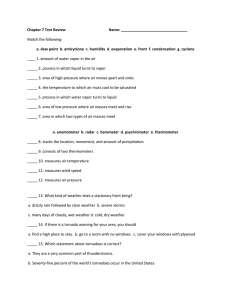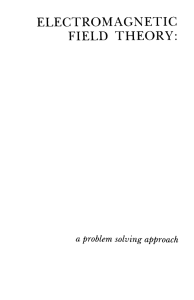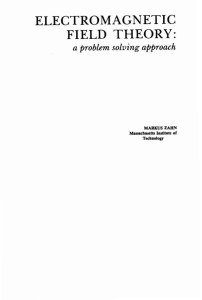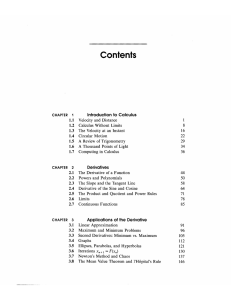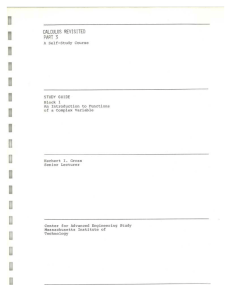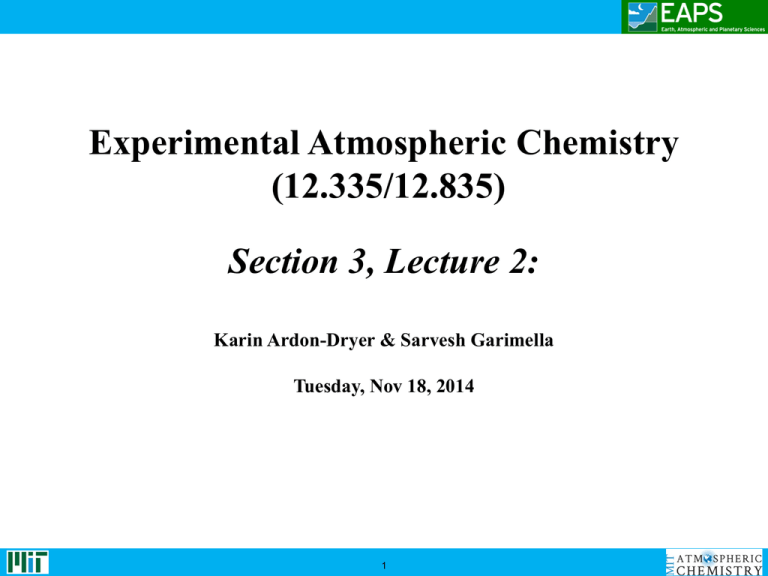
Experimental Atmospheric Chemistry
(12.335/12.835)
Section 3, Lecture 2:
Karin Ardon-Dryer & Sarvesh Garimella
Tuesday, Nov 18, 2014
1
Today : Cloud Droplet Formation
RH & Saruration
Liquid water from 0 – 100% RH
RH of 100% +
Kelvin Köhler curve
Cloud droplets
CCN counter
2
Relative Humidity ~ Saturation
A term used to describe the amount of water vapor
that exists in a gaseous mixture of air and water vapor.
The relative humidity of an air-water mixture
defined as the ratio of :
Actual Vapor Density
(amount of moisture in air)
Relative Humidity (RH) = ------------------------------Saturation Vapor Density
(amount in saturated air)
3
X 100%
Relative Humidity ~ Saturation
The relative humidity of an air-water
mixture defined as the ratio of :
e
es
e - vapor pressure of environment
es - vapor pressure of saturated environment
e
e
es > 1 supersaturated
es < 1 sub-saturated
e
es = 1 saturated
When evaporation = Condensation
RH = 100%
Evaporation Condensation
No water vapor
Flat water
surface covered
Pure H2O
Saturated Air
Condensation
rate
Evaporation
rate
Water
Condensation
rate
Evaporation
rate
If RH <100% water/cloud will evaporate
If RH >100% water/cloud will condense
Figure by MIT OpenCourseWare.
4
Content
6 oz water
6 oz water
6 oz water
9 oz water
Capacity
6 oz glass
9 oz glass
12 oz glass
12 oz glass
Relative Humidity
6/6 x 100 = 100%
6/9 x 100 = 67%
6/12 x 100 = 50%
9/12 x 100 = 75%
Temperature
20oC
Low
Medium
10oC
High
0oC
7g
H2O vapor
7g
H2O vapor
1 kg Air
1 kg Air
1 kg Air
(A) Initial Condition (B) Cooled to 10oC
Temperature
Air
Capacity
H2O Vapor Content
Relative Humidity
3.5 g
H2O vapor
3.5 g
H2O liquid
(C) Cooled to 0oC
20 C
1 kg
10 C
1 kg
0oC
1 kg
At 20oC=14 grams
7 grams
At 10oC=7 grams
7 grams
At 0oC=3.5 grams
3.5 grams
7/14=50%
7/7=100%
3.5/3.5=100%
o
o
Figure by MIT OpenCourseWare.
5
Deliquescence and Efflorescence
Deliquescence (DRH) - process by which a substance absorbs moisture from the
atmosphere until it dissolves in the absorbed water and forms a solution.
Efflorescence (ERH) - spontaneous loss of water by a hydrated salt, which
occurs when the aqueous vapor pressure of the salt is greater than the partial
pressure of the water vapour in the air.
2.0
Increasing RH
Solid Particle
Liquid Particle
Deliquescence
1.5
Decreasing RH
Solid Particle
Liquid Particle
1.0
Efflorescence
Figure by MIT OpenCourseWare.
© sources unknown. All rights reserved. This content is excluded from our Creative
Commons license. For more information, see http://ocw.mit.edu/help/faq-fair-use/.
6
Deliquescence and Efflorescence
2.4
(NH4)2SO4 Ammonium sulfate
2.2
2.0
(NH4)2SO4
Dp /Dp0
1.8
1.6
1.4
1.2
1.0
0.8
0
5 10 15 20 25 30 35 40 45 50 55 60 65 70 75 80 85 90 95 100
Relative Humidity, %
Diameter change of (NH4)2SO4, NH4HSO4, and H2SO4 particles as a function of
relative humidity. Dp0 is the diameter of the particle at 0% RH.
Figure by MIT OpenCourseWare.
DRH is material specific
DRH changes with T per “Clausius-Clapyeron” relation
ERH is not predictable but follows nucleation theory
7
Seinfeld and Pandis, 2006
Deliquescence and Efflorescence
TABLE: Efflorescence Relative Humidity
at 298 K
TABLE: Deliquescence Relative Humidities
of Electrolyte Solutions at 298 K
Salt
DRH (%)
Salt
ERH (%)
NaCl
75.3 + 0.1
NaHSO4
NaNO3
52.0
NaCl
43 + 3
74.3 + 0.4
NaNO3
Not Observed
Na2SO4
84.2 + 0.4
Na2SO4
56 + 1
NH4Cl
80.0
NH4Cl
45
NH4HSO4
40.0
NH4HSO4
Not Observed
(NH4)3H(SO4)2
69.0
(NH4)H(SO4)2
35
NH4NO3
61.8
NH4NO3
Not Observed
(NH4)2SO4
79.9 + 0.5
(NH4)2SO4
35 + 2
KCl
84.2 + 0.3
KCl
59
Source: Martin (2000).
Source: Tang (1980) and Tang and Munkelwitz (1993).
Figures by MIT OpenCourseWare.
Figures by MIT OpenCourseWare.
8
Seinfeld and Pandis, 2006
Deliquescence & Efflorescence of two Component Systems
Particle Mass/Dry Particle Mass
7
Two (or more) components
6
More favorable state is solution
sooner when a second component is
added (regardless of the DRH)
5
KCl/NaCl
DRH
4
NaCl (Sodium chloride ) 75.3%
KCI (potassium chloride) 84.2%
Mixed-salt particle 72.7%
3
2
ERH
1
NaCl (Sodium chloride ) 43%
KCI (potassium chloride) 59%
0 60
65
70 75 80 85 90 95
Relative Humidity, %
Crystallization
Deliquescence
Hygroscopic growth and evaporation of a mixed-salt particle
composed initially of 66% mass KCl and 34% mass NaCl.
Figure by MIT OpenCourseWare.
9
Seinfeld and Pandis, 2006
‘Haze’ or Deliquesced -> Droplet
Comparative sizes, concentrations, and terminal fall velocities
of some of the particles included in cloud and precipitation processes
Conventional borderline
between cloud drops
and raindrops
r = 100
v = 70
Large cloud drop
r = 50
n = 103
V = 27
Typical condensation nucleus
r = 0.1
n = 106
V = 0.0001
Typical cloud drop
r = 10
n = 106
V=1
KEYS
Typical raindrop r = 1000, n = 1, V = 650
r - radius in microns
n - number per liter
V - terminal velocity in centimeters per second
Figures by MIT OpenCourseWare.
10
Approaching 100%
This image has been removed due to copyright restrictions.
Please see: http://www.harding.edu/lmurray/113_files/html/d2_earth%20revised/img037.jpg.
Heating reduces RH, cooling increases RH
(day/night variation and concept of dew point and frost point)
Parcel rise of fall (‘adiabatic’) results in condensation or evaporation
11
Creation of clouds droplets
Homogeneous Nucleation
Drop of pure water forms from vapour
Heterogeneous Nucleation
Collection of water molecules on a foreign
substance
12
Homogeneous Nucleation
There are a lot of molecule in the air in supersaturation,
in order to create a drop the molecule need to become
attached to each other
Water vapor molecules
Embryonic droplet of radius R
Growth of the pure water embryo depend on the difference
between es and e
e < es
e > es
decay (vapor moves away from the drop)
growth (vapor moves toward the drop)
When the pure water embryo drop radius is e = es
The droplet is just large enough to be stable
13
Homogeneous Nucleation
Saturation above a pure water droplet of a know
radius is:
𝑒
2𝜎𝐿𝑉
r- embryo drop radius
=
𝑒𝑥𝑝
T- temperature
𝑒𝑠
𝑛𝐿 𝑘𝑇𝑟
k- Boltzmann constant
σLV - surface tension of water molecules
e - vapor pressure of environment
es - vapor pressure of saturated environment (water molecules)
nL - number of water molecules/unit volume in the liquid phase
e/es< 1 sub-saturated
e/es> 1 super-saturated
e < es
decay (vapor moves away from the drop)
e > es
growth (vapor moves toward the drop)
14
Homogeneous Nucleation
Kelvin’s equation for critical radius for initial droplet
to “survive”, strongly dependent on supersaturation
2 vl
Rc
ρL- liquid density
e
Rv LT ln e
T- temperature
s
Rv- gas constant (8.314472JK-1mol-1)
Rc- critical radius
e - vapor pressure of environment
es - vapor pressure of saturated environment
σLV - surface tension between the liquid-vapor phases (0.076Jm−2)
15
Homogeneous Nucleation
TABLE: Radii and Number of Molecules in Droplets of
Pure Water in Equilibrium with the Vapor at 0°
Saturation Ratio
S
Critical Radius
rc (µm)
Number of Molecules
n
10
5.221 X 10-4
20
5
7.468 X 10-4
58
4
8.671 X 10-4
91
3
1.094 X 10-3
183
2
1.734 X 10-3
730
1.5
2.964 X 10-3
3.645 X 103
1.10
1.261 X 10-2
2.807 X 105
1.01
1.208 X 10-1
2.468 X 108
1
∞
∞
Figures by MIT OpenCourseWare.
Smaller pure drop need higher supersaturation, and less
molecules in order to grow.
16
Homogeneous Nucleation
• Statistical thermodynamic
calculations show that
Saturation ratio must be
300-600%
for
one
homogeneous nucleation
event per cm3 per second
in the natural atmosphere.
• Since Saturation ratio rarely
exceeds 1-2%,
Homogeneous nucleation is never consistently achieved.
17
Heterogeneous Nucleation
In this section we will examine the production of
small water droplets nucleated with the aid of a
foreign particle.
Since nucleation takes place with something in
addition to pure water vapor, the nucleation process
is called heterogeneous.
Image courtesy of NASA.
http://earthobservatory.nasa.gov/Features/GlobalClouds/
18
For a water molecule in the salt solution which is inside a water
drop just like before:
e’ - vapor pressure of water vapor above a solution.
es vapor pressure above a plane surface of pure water.
f - mole fraction of water in the solution.
moles water is:
moles salt is:
(4/3πr3ρ’− m)/M0
ims/M
19
m = mass of salt in solution
M = molecular weight of the salt
M0 = molecular weight of water
i = Van’t Hoff factor
Solution Effect (Raoult’s Law)
© John Wiley & Sons, Inc. All rights reserved. This content is excluded from our Creative
Commons license. For more information, see http://ocw.mit.edu/help/faq-fair-use/.
The vapor pressure of water over NaCl and (NH4)2SO4 solutions is shown in Figure 17.3. Also shown is the ideal solution behavior.
Note that because NaCl dissociates into two ions, the number of equivalents in solution is twice the number of moles of NaCl. For
(NH4)2SO4, the number of ions in solution is three times the number of dissolved salt moles. In calculating the number of moles in
solution, ns, a dissociated molecule that has dissociated into i ions is treated as i molecules, whereas an undissociated molecule is
counted only once. A similar diagram is given in Figure 17.4, using now the concentration of salt as the independent variable. Solutes
that dissociate (e.g., salts) reduce the vapor pressure of water more than do solutes that do not dissociate, and this reduction
depends strongly on the type of salt.
20
Seinfeld and Pandis, 2006
The saturation ratio for a solution droplet must still be
given by this relation since we must require the droplet to
be in equilibrium with the vapor
For sea salt
𝑒𝑟
𝐴 𝐵
= exp
−
𝑒𝑠
𝑟 𝑟3
A=2 /wRvT
B=(3imsMw)/(4Msw)
-5
×
im s
3.3 10
3
B
4
.
3
(cm
)
(cm)
A
Ms
T
21
r- drop radius
ms- masses of salt
Ms – molecular weight
i = Van’t Hoff factor
Saturation rate as a function of the drop size
𝑒𝑟
𝐴 𝐵
𝑆 = =1+ − 3
𝑒𝑠
𝑟 𝑟
er -Vapor pressure
es - saturation vapor pressure over a plane surface of pure water.
RH (Relative Humidity)= s × 100%
Supersaturation = S= (s + 1)
22
Kelvin Köhler curve
If we plot the saturation with r for a given salt type and salt mass, we
obtain a set of curves known as the Köhler curves.
Kelvin curve
r* = (3b/a)1/2
S* = 1+(4 a3/[27b])½
© sources unknown. All rights reserved. This content is excluded from our Creative
Commons license. For more information, see http://ocw.mit.edu/help/faq-fair-use/.
23
Kelvin Köhler curve
Saturation Ration
S
S*
Sb
Sa
b
a
ra
rb r*
Drop Radius (μm)
r
A drop at point a (r=ra, S=Sa). Let
the Supersaturation to increases to
Sb, the drop will grow to radius rb.
If the Supersaturation drops again,
the drop will get smaller.
But if the Supersaturation will
increase
to
the
critical
Supersaturation condition (r=r*,
S=S*) the drop will grow to a
critical radius.
From now on the drop will
continue growing spontaneously
(by diffusion), even if the
Supersaturation decrease.
24
Haze and cloud drop -Köhler curves
Köhler curve
Cloud drop
activated
haze
© sources unknown. All rights reserved. This content is excluded from our Creative
Commons license. For more information, see http://ocw.mit.edu/help/faq-fair-use/.
Drop below the critical radius called haze particle
Drop above the critical radius called clouds drop their aerosol are
activated aerosol
25
Köhler curves
rc, Sc
Sc = 1+(4 a3/[27b])½
rc = (3b/a)1/2
26
This image has been removed due to copyright restrictions.
Please see: Figure 17.5 of the book Atmospheric Chemistry and Physics: From Air
Pollution to Climate Change. Wiley-Interscience, 2006. ISBN: 9780471720188.
Bigger particle are more effective than small ones, but their concentration in the cloud is lower
27
Seinfeld and Pandis, 2006
SS vs. Critical Diameter
This image has been removed due to copyright restrictions.
Please see: Figure 17.6 of the book Atmospheric Chemistry and Physics: From Air
Pollution to Climate Change. Wiley-Interscience, 2006. ISBN: 9780471720188.
28
Seinfeld and Pandis, 2006
Mass of dissolved
salt [gr]
rsalt[ m ]
r*[ m ]
S*[%]
10-16
0.0223
0.19
0.42
10-15
0.0479
0.61
0.13
10-14
0.103
1.9
0.042
10-13
0.223
6.1
0.013
10-12
0.479
19
0.0042
r*
, S*
as dry particle diameter (or mass) increases
r*
, S*
as dry solute molecular weight increases
29
Insoluble Components
Most atmospheric particles contain both water-soluble and waterinsoluble substances (dust, elemental carbon, etc.).
The effect of the insoluble material is to
increase in absolute terms the solute
effect. Physically, the insoluble material
is responsible for part of the droplet
volume, displacing the equivalent water.
Therefore, for the same overall droplet
diameter, the solution concentration will
be higher and the solute effect more
significant.
This image has been removed due to copyright restrictions.
Please see: Figure 17.8 of the book Atmospheric Chemistry and
Physics: From Air Pollution to Climate Change. Wiley-Interscience,
2006. ISBN: 9780471720188.
Köhler curves for a particle consisting of various combinations of (NH 4)2SO4 and insoluble material
We see that the smaller the water-soluble fraction the higher the supersaturation needed
for activation of the same particle, and the lower the critical diameter.
30
Seinfeld and Pandis, 2006
Insoluble Components
These images have been removed due to copyright restrictions.
Please see: Figures 17.8 and 17.9 of the book Atmospheric Chemistry and Physics: From
Air Pollution to Climate Change. Wiley-Interscience, 2006. ISBN: 9780471720188.
The smaller the Ɛmthe higher the supersaturation needed for
activation of the same particle size
31
Seinfeld and Pandis, 2006
CCN - (Cloud Condensation Nuclei)
The ability of a given particle to serve as a nucleus for water droplet
formation will depend on its:
• Size
• Chemical composition
• Local supersaturation
Aerosol that consider as a “good candidate” for condensation nuclei are:
• Hygroscopic aerosol.
• Bigger Aerosol with a critical radius can nucleate at low
supersaturation (according to Köhler curve)
Hygroscopic aerosol can be larger than
~ 0.01 µm in order to nucleate.
Image courtesy of NASA.
http://earthobservatory.nasa.gov/Features/GlobalClouds/
32
Köhler curve with GCCN
Cloud drop
GCCN
area
© sources unknown. All rights reserved. This content is excluded from our Creative
Commons license. For more information, see http://ocw.mit.edu/help/faq-fair-use/.
33
Cloud Condensation Nucleus Counter (CCNC)
The CCN Counter is a continuous-flow thermalgradient diffusion chamber for measuring
aerosols that can act as cloud condensation
nuclei.
This image has been removed due to copyright restrictions.
Please see: http://www.dropletmeasurement.com/
sites/default/files/pictures/Products/CCN/CCN.png.
© James Smith, UCAR. All rights reserved. This content is
excluded from our Creative Commons license. For more
information, see http://ocw.mit.edu/help/faq-fair-use/.
http://www.dropletmeasurement.com/
http://acd.ucar.edu/~jimsmith/POP/instruments_files/CCNc.htm
34
Cloud Condensation Nucleus Counter (CCNC)
•
•
•
•
Water vapor is saturated at the column wall at
all points.
Diffusing heat originates at Point A, while
diffusing mass originates at Point B.
The actual partial water pressure of water vapor
at C equals the partial pressure of water vapor
at B.
However, the temperature at C is lower than at
B, meaning there is more water vapor than
thermodynamically allowed.
© James Smith, UCAR. All rights reserved. This content is
excluded from our Creative Commons license. For more
information, see http://ocw.mit.edu/help/faq-fair-use/.
© sources unknown. All rights reserved. This content is excluded
from our Creative Commons license. For more information,
see http://ocw.mit.edu/help/faq-fair-use/.
35
How Do We Measure CCN?
Initial size is selected with a
DMA
This image has been removed due to copyright restrictions.
Please see Figure 1 on page: http://www.tandfonline.com/
doi/full/10.1080/02786820903289780.
Supersaturation due to T
gradient used for activation
36
Moore and Nenes AST 2009
CCN Use in Models
This image has been removed due to copyright restrictions.
Please see: Figures 17.16 of the book Atmospheric Chemistry and Physics: From
Air Pollution to Climate Change. Wiley-Interscience, 2006. ISBN: 9780471720188.
n(Dp) - number distribution of the aerosol population
Ds - activation diameter for s% supersaturation of these particles
fs(Dp) - fraction of the aerosol particles of diameter Dp that are activated at s%
37
Seinfeld and Pandis, 2006
Historically, one counted aerosol and determined number activated as
a function of s (atmospheric supersaturation, %).
Relationship: CCN (s) = c sk
Activity Spectrum (cm-3)
10000
CCN(s) - particles cm- 3
s - supersaturation expressed as a percentage
C - constant c corresponds to the CCN(1%), the
particles active at 1% supersaturation.
Number of aerosol going to nucleation
Nc = C sk
1000
Marine:
Continental:
C=150
k=0.6
C=1500
k=1.1
100
maritime:
N(continental)
Continental:
N(marine)
10
0
0.5
1
Supersaturation (%)
1.5
2
38
C=10-300 cm-3
k=0.3-1.0
C=200-1000 cm-3
k=0.2-2.0
This image has been removed due to copyright restrictions.
Please see: Figures 17.4 of the book Atmospheric Chemistry and
Physics: From Air Pollution to Climate Change. Wiley-Interscience,
2006. ISBN: 9780471720188.
This image has been removed due to copyright restrictions.
Please see: Figure 5 on page, http://olympic.atmos.colostate.
edu/AT620/papers/Hudson_and_Yum.pdf.
39
Hudson_and Yum 2001
Account for Composition - k -Köhler equations
The saturation ratio, S, over an aqueous solution
droplet can be calculated from
where aw is the activity of water in solution, ρw is
the density of water, Mw is the molecular weight
of water, σs/a is the surface tension of the
solution/air interface, R is the universal gas
constant, T is temperature, and D is the diameter
of the droplet.
where A=8.69251×10−6 σs/a /T is a
constant that is evaluated at σs/a
=0.072 Jm−2 and T =298.15K (PK07)
PK07 proposed a hygroscopicity parameter that
is defined through its effect on the water activity
of the solution:
where Vs is the volume of the dry particulate
matter (both soluble and insoluble) and Vw is
the volume of the water.
40
Petters and Kreidenweis ACP 2008
k -Köhler equations
This image has been removed due to copyright restrictions.
Please see: Figure 2 on page, http://www.atmos-chem-phys.net/
7/1961/2007/acp-7-1961-2007.pdf.
Lower k indicate on less
hygroscopic or less CCN activity
41
Petters and Kreidenweis ACP 2008
This image has been removed due to copyright restrictions.
Please see: Figure 5 on page, http://www.atmos-chem-phys.net/
14/6003/2014/acp-14-6003-2014.pdf.
42
Garimella et al. 2014 ACP
Until now we only create small cloud drop
Comparative sizes, concentrations, and terminal fall velocities
of some of the particles included in cloud and precipitation processes
Conventional borderline
between cloud drops
and raindrops
cities
r = 100
v = 70
Large cloud drop
r = 50
n = 103
V = 27
This image has been removed due to copyright
restrictions. Please see the first image on page:
http://conveccion.at.fcen.uba.ar/practicas/
NUBES.pdf.
Typical condensation nucleus
r = 0.1
n = 106
V = 0.0001
Typical cloud drop
r = 10
n = 106
V=1
cities
KEYS
Typical raindrop r = 1000, n = 1, V = 650
r - radius in microns
n - number per liter
V - terminal velocity in centimeters per second
Figure by MIT OpenCourseWare.
43
This image has been removed due to copyright
restrictions. Please see: https://gnightearth.
files.wordpress.com/2014/06/slide0001_
image060.jpg.
As result of the raising air and cooling
the droplets are going through:
1.Evaporation
2.Gravity
3. Condensation
4. Collision-coalescence
This image has been removed due to copyright restrictions.
Please see the first image on page: http://conveccion.
at.fcen.uba.ar/practicas/NUBES.pdf.
44
Collision-coalescence
In order for the Collision –
Coalescence process to be
effective, a minimum 20 μm drop
is needed. From this size the drop
can collect smaller drops.
Conventional borderline
between cloud drops
and raindrops
cities
r = 100
v = 70
Large cloud drop
r = 50
n = 103
V = 27
Typical condensation nucleus
r = 0.1
n = 106
V = 0.0001
Typical cloud drop
r = 10
n = 106
V=1
cities
Typical raindrop r = 1000, n = 1, V = 650
KEYS
1 mm drop is a product of 100,000
Collisions and Coalescences
Comparative sizes, concentrations, and terminal fall velocities
of some of the particles included in cloud and precipitation processes
r - radius in microns
n - number per liter
V - terminal velocity in centimeters per second
Figure by MIT OpenCourseWare.
For 30 μm drop collision is the main growing
process.
Larger particles sweep out smaller cloud droplets.
45
46
MIT OpenCourseWare
http://ocw.mit.edu
12.335 / 12.835 Experimental Atmospheric Chemistry
Fall 2014
For information about citing these materials or our Terms of Use, visit: http://ocw.mit.edu/terms.



